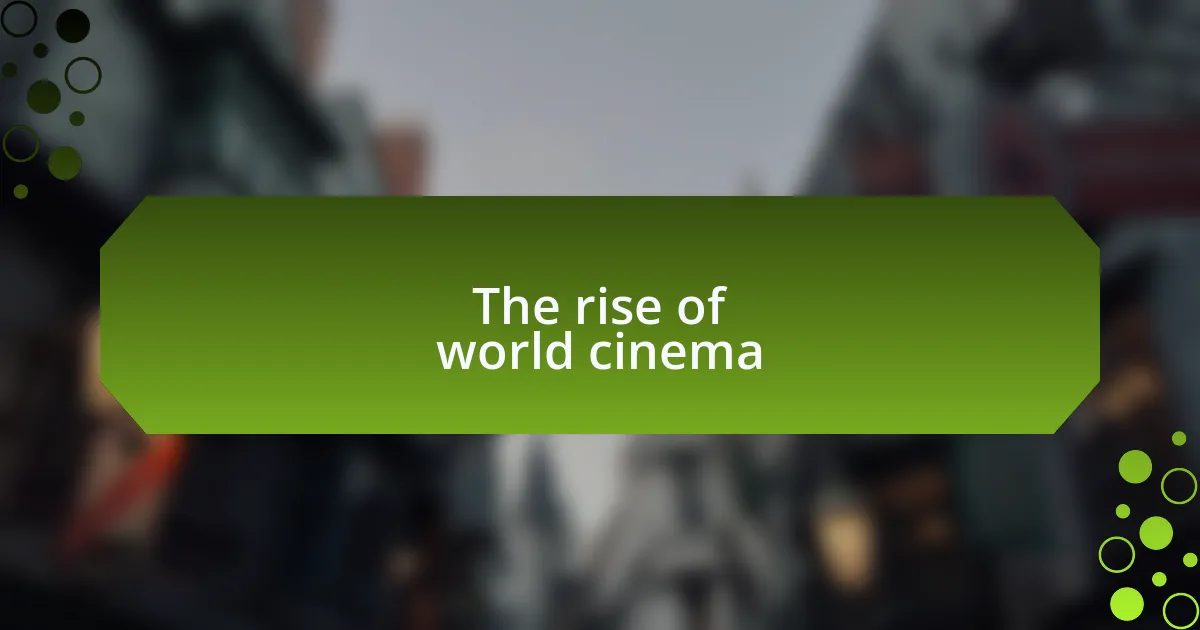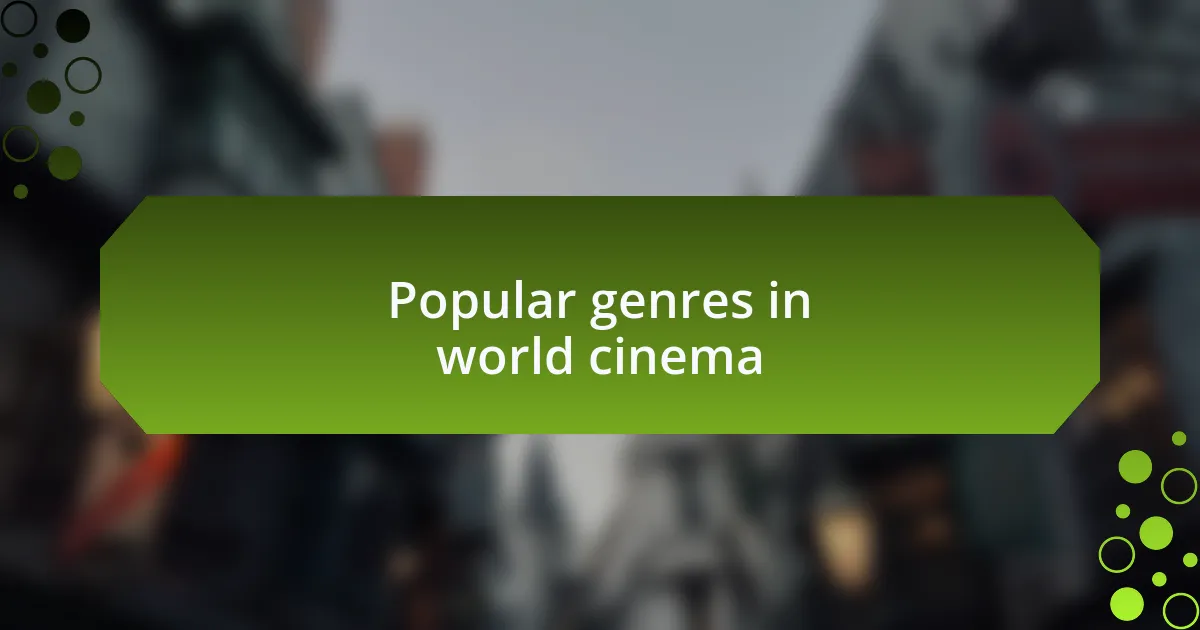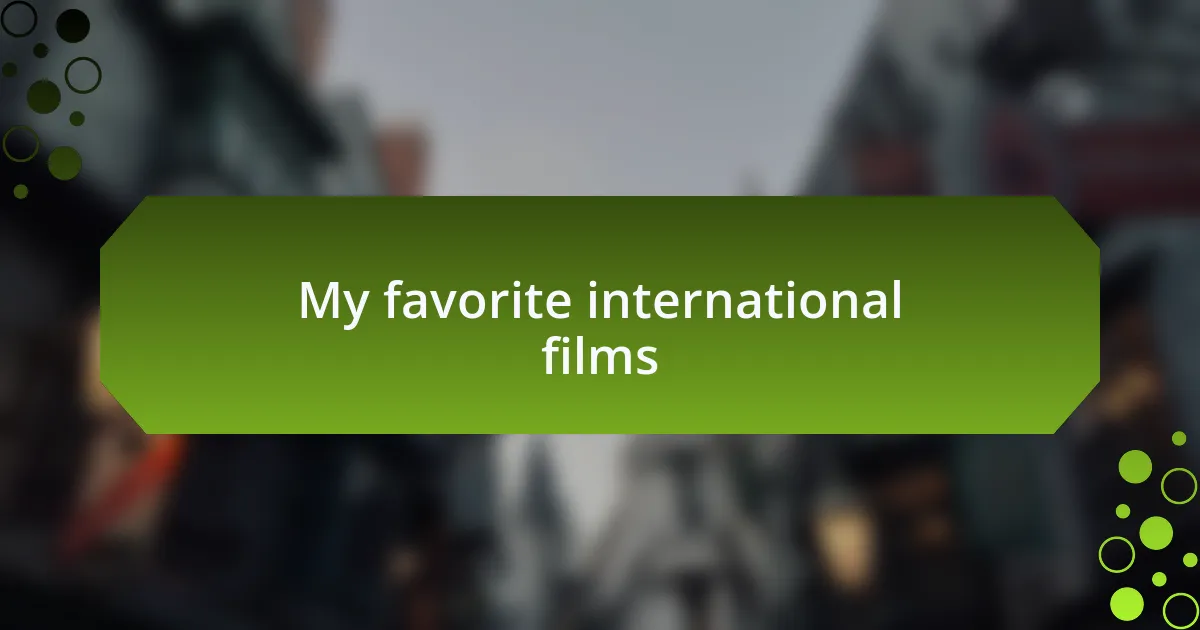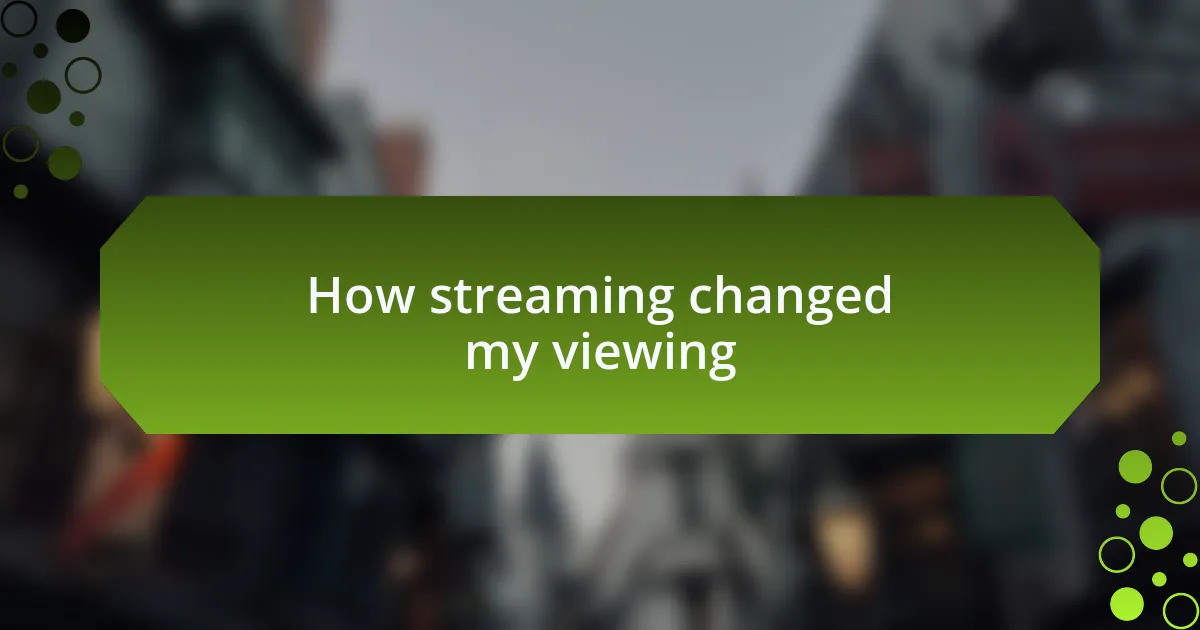Key takeaways:
- Movie streaming has transformed content consumption, allowing easy access to diverse films from around the world.
- The rise of world cinema has diversified storytelling, inviting audiences to explore different cultures and perspectives.
- Cultural contexts in international films enhance understanding and empathy, showcasing unique narratives that often resonate universally.
- Personal reflections from films, like “Parasite” and “City of God,” encourage deeper conversations about social issues and human experiences.

Understanding movie streaming
Movie streaming has revolutionized the way we consume content. I remember the first time I experienced this shift – I was cozy at home, scrolling through countless film options at my fingertips. It struck me how different it was from the days of renting DVDs and waiting in line at local stores.
In my journey through this digital landscape, I often wonder how streaming services curate their vast libraries. Some platforms seem to have endless choices, while others focus on specific genres. It makes me think about how personal taste influences what we watch and how we discover new films.
The thrill of finding hidden gems on a streaming service can be exhilarating. I recall stumbling upon a foreign film that completely changed my perspective on storytelling. Isn’t it refreshing how streaming allows us to explore diverse cultures and narratives without leaving our living rooms? This accessibility has opened doors for countless filmmakers, enriching our cinematic experience.

The rise of world cinema
The rise of world cinema has been a remarkable journey, fueled by our increasing desire for diverse perspectives in storytelling. I remember watching a powerful Iranian film late one night; the emotions it stirred were unlike anything I had encountered before. It made me ponder – how many voices from around the globe have been waiting to be heard, and how has streaming introduced us to these hidden treasures?
Streaming platforms have played a pivotal role in popularizing international films, often curating collections that spotlight underrepresented cultures. I can’t help but feel excited when I see a new collection dedicated to Spanish or Korean cinema pop up on my favorite service. These curated experiences invite us to step outside our own narratives and immerse ourselves in rich, complex worlds crafted by talented filmmakers from different backgrounds.
Moreover, the rise of social media has transformed how we engage with world cinema. I vividly recall joining an online discussion about a recent French film I watched, where viewers from all over the world shared their interpretations. It struck me then – does this level of connectivity deepen our appreciation for global stories? I believe it does; it fosters a community that embraces artistic diversity and celebrates our shared human experience.

Popular genres in world cinema
When exploring world cinema, I find that certain genres stand out for their universal appeal and cultural depth. For instance, drama often transcends borders, showcasing the triumphs and tribulations of the human experience. I recall a particularly gripping Indian drama that not only moved me emotionally but also offered a glimpse into societal issues that felt both foreign and familiar.
Then there’s the allure of international thrillers, which never fail to captivate me with their intricate plots and unique storytelling techniques. I remember watching a South Korean thriller that had me on the edge of my seat, completely engrossed in its suspense. It made me think — how do different cultures build tension and suspense in ways that feel both new and thrilling?
Lastly, I can’t overlook the impact of documentary cinema, which serves as a powerful medium for social commentary. Just the other day, I watched a Brazilian documentary that opened my eyes to the challenges faced by indigenous communities. It sparked reflections on my own life and prompted me to ask — how can storytelling in this genre promote understanding and spark change? World cinema’s diversity in genres not only entertains but also empowers us to expand our perspectives and foster empathy.

My favorite international films
When I think about my favorite international films, I can’t help but mention “Amélie,” a whimsical French film that brought a sense of magic into my life. Its quirky storytelling and vibrant cinematography reminded me of the beauty in life’s small moments. I often revisit this film, as it encourages me to find joy in ordinary experiences — a lesson I believe is universally valuable.
Another gem that stands out is the Japanese film “Spirited Away.” I was completely captivated by its enchanting animation and profound themes of resilience and growth. It made me reflect on my own journey, as Chihiro navigates a world filled with challenges and fantastical creatures, evoking a deep sense of nostalgia for childhood adventures. Have you ever felt that a film touched your life in ways you didn’t expect?
Lastly, I can’t forget “City of God,” a powerful Brazilian film that exposes the harsh realities of life in the favelas. Watching it stirred a mix of emotions; I felt both heartbroken and inspired by the resilience displayed by the characters. It left me questioning how art can serve as a catalyst for change in societies plagued by inequality. Each of these films has left an indelible mark on my heart and shaped the way I view the world.

How streaming changed my viewing
As I transitioned to streaming platforms, I realized that my viewing experience underwent a profound transformation. Suddenly, I had access to a plethora of films from around the globe, right at my fingertips. This abundance made me question: how could I ever go back to traditional cable? The curated collections of international cinema opened up new worlds and perspectives that I’d never encountered before.
One night, while scrolling through a streaming service, I stumbled upon a South Korean film, “Parasite.” I remember being utterly engrossed in its storyline and themes of class disparity. It wasn’t just a movie to me that night; it was a window into a culture and society that I knew so little about. Watching such impactful narratives from my couch made me feel connected to global issues in a way that I hadn’t experienced before.
Streaming has also changed how I feel about time spent watching movies. Gone are the days of rushing to catch a film at a specific time; now I can savor films as a personal journey. Have you ever paused a movie to reflect on a scene that resonated with you? I often find myself doing this, letting the emotions wash over me, and diving deeper into the storyline, which enhances my connection to the film. This sense of immediacy and availability has deepened my appreciation for world cinema, allowing me to engage with stories that push boundaries.

Exploring cultural contexts in movies
Exploring cultural contexts in movies opens up a treasure trove of understanding and empathy. I recall watching a Brazilian film, “City of God,” which transported me to the vibrant yet challenging neighborhoods of Rio de Janeiro. The raw portrayal of life there forced me to confront issues of poverty and violence, leaving me with a lingering sense of urgency to appreciate my own surroundings more deeply. How often do we get to feel the pulse of another culture through art?
Diving into Indian cinema, especially films like “The Lunchbox,” was another eye-opening experience. The subtle storytelling and intricate character dynamics revealed the nuances of relationships within a society swirling with tradition and modernity. I found myself wondering how something so culturally specific could feel so universally relatable—an emotional resonance that sparked discussions with friends about the ties that bind us across cultures.
I often think about how cultural contexts alter our perceptions when we watch these films. For instance, experiencing a French romantic drama taught me the different ways love is expressed, contrasting significantly with how I had perceived it through Hollywood narratives. These films often act as bridges, linking us to worlds where traditions, celebrations, and struggles enhance our understanding of humanity. Each viewing becomes more than just a cinematic experience; it morphs into a dialogue between cultures that invites us to expand our horizons.

Lessons learned from my journey
Reflecting on my journey through world cinema, one of the big lessons I’ve learned is the importance of perspective. I remember watching “A Separation,” an Iranian film, and being struck by how it showcased moral dilemmas in such a nuanced way. It made me question my own judgments and biases—how often do we overlook the complexities of someone else’s reality just because it’s different from our own?
Another lesson stands out: the power of storytelling to unite us. After viewing the South Korean masterpiece “Parasite,” I was left pondering the stark contrasts between social classes. It amazed me how this film could provoke conversations about inequality that resonated universally, regardless of my cultural background. Isn’t it fascinating how a tale from halfway across the globe can spark such deep introspection and dialogue about our shared human experience?
Lastly, I realized that every film is a mirror reflecting my own life experiences and emotions. Watching “Cinema Paradiso” took me on a nostalgic journey back to my childhood, where movies were a safe haven and a source of imagination. I often wonder—how do our own narratives shape the way we connect with others’ stories? Embracing this awareness has enriched my view of cinema and deepened my empathy towards the myriad lives depicted on screen.